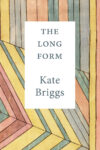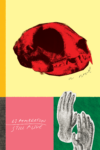Washington D.C. is a hotbed of political interest and intrigue. Paula Whyman’s You May See a Stranger embodies the tumult of the nation’s capital. I read the collection of short stories in one sitting and jumped at the chance to interview the author.
You May See a Stranger collects stories about family, love, loathing and survival. Is the protagonist, Miranda, still whole by the end of the book? Or has a part of her been cut out never to be reinstated? These are the questions I thought over while reading Whyman’s debut book.
Whyman and I corresponded via email in the early summer. The following interview has been edited for length and clarity.
Editor’s note: Read Dhaaruni Sreenivas’s review of You May See a Stranger here.
Dhaaruni Sreenivas: What made me saddest about this book was the relationship between Miranda and her sister Donna. What was the inspiration for that relationship? I thought it was delicately and empathetically portrayed.
Paula Whyman: Thank you; I’m glad the relationship between Miranda and Donna was affecting, and effective. I’m curious about all kinds of relationships, and I think all sibling relationships are fraught and complicated and interesting to examine. There’s no specific basis I can point to for most any of my stories. That’s the great thing about writing fiction—I can make it all up! I did have a brother who had Williams Syndrome. We got along well. Williams Syndrome people are often social butterflies, so quite the reverse of Miranda’s sister. (Oliver Sacks wrote about Williams people in Musicophilia.) I spent a lot of time around my brother’s friends, who had many different types of disabilities, and when I was a teenager I babysat for children with severe disabilities. I gained something of an inside view of what that was like, in particular also the stress it can place on a marriage.
There’s this song by Brandy Clark, a country artist, called “Girl Next Door” which I was really reminded of when reading You May See a Stranger. It has the lyrics “My heart and my head and my bed can get real twisted/And you wouldn’t be the first to think you could go and fix it.” Miranda recalls that sentiment. Do you think the men in Miranda’s life see her for who she is? Or do they see what they want to see?
I’ll have to listen to that song! Doesn’t everyone see what they want to see, at least until time passes and they get to know someone? Then reality sets in, for better or worse. I do think Miranda sometimes confuses sexual attention with true affection. Only a few of these men seem to take the time to know her. But it goes both ways. I’m not sure she’s asking or expecting a whole lot from some of those relationships. I also sometimes think girls and women are expected to seek deeper attachments all the time, whereas men are “permitted” the occasional shallow fling. This is a throwback attitude, of course, an undercurrent of bias, but I think that in some cases, it still operates.
Likability is something you’ve probably thought about a lot; it’s practically a buzzword in modern literature. As somebody that’s not white but who embodies a lot of qualities we associate with “poor little rich (white) girls,” I wonder what Miranda would be like if she wasn’t white? Or, is she actually not white and I’m just reading into her coding as “troubled” and “a hot mess?” As a society, we demand perfection in women of color yet we’re beginning to distance ourselves from that notion in white women. I’m pondering the buzzword, likability, and how it is applied to women. Basically, could Miranda exist as she is if she wasn’t white? And how does race affect likability?
I think we demand perfection from women in general—perhaps from people—but not in fiction. In fiction, only a flat character can be “perfect,” and I’d rather not read about a flat character. That would be terribly boring. I’m interested in reading about female and male characters who push the limits of acceptable behavior. That’s far more interesting to me. And that’s an advantage in writing fiction—you can push your characters to the edge and see what happens. But if you mean Miranda seems privileged in some ways because she’s white, it’s true that her eyes are opened in some of the stories when she’s forced to confront issues of race.
I’ve said elsewhere that I think “unlikable” is different from “unsympathetic.” Miranda’s behavior may not be likable, but it’s relatable. I don’t think her behavior is accepted by the reader because she’s white, but because she’s human.
Where do you think the line is drawn regarding likability? Does it differ for women and men? There’s this deep-seated humanity in everything Miranda does and thinks, even though it’s occasionally despicable on a surface level. I, for one, couldn’t read a book from the perspective of a rapist or a serial killer because it would fundamentally disturb me too much. That’s partially why I could never read The Kid, Sapphire’s sequel to Push. I couldn’t stomach it, which is perhaps a flaw of mine, but I’m interested to see what you think about this.
I’m glad you see Miranda’s humanity! I wouldn’t describe her behavior as “despicable,” though; I see her as a flawed human, and one I enjoyed trying to understand. I’m not bothered by questions of likability. I don’t think about that when I’m reading or writing. I like my characters complicated. People are complicated. When I think of my favorite male and female protagonists, all of them are deeply flawed—that’s what makes them seem most human. I’m thinking of Isabel Archer in The Portrait of a Lady; Portnoy in Portnoy’s Complaint; Mickey Sabbath in Sabbath’s Theater; Lily Bart in The House of Mirth; and the title character in a much more recent book, Rainey Royal by Dylan Landis. On the other hand, the kind of character who makes me angry, who makes me want to shut the book and not return to it, is one who is unconvincing in context, whose behavior is inconsistent, who seems like a pawn for the author’s goals. Or, a flat character—see my comments above about being “perfect.” Regarding where you draw the line in what you’re willing to read, we all have our limits. I don’t like it when ghastly things happen to small children in stories, especially if it seems gratuitous.
Miranda takes responsibility for her actions even though she isn’t apologetic in the least. She always comes across as an adult to me, even when she’s much younger. Was that intentional? There are people who might claim it’s unrealistic that a fifteen-year-old could be as contemplative as Miranda, but I think it makes a lot of sense based on her upbringing and her relationship with her sister.
Oh, I do think there are kids like that, introspective, smart kids. I’ve met some. I wanted to write about an intelligent, thoughtful person, for the same reason I wanted to write about someone who pushes the limits—it’s more interesting for me, and I hope, as a result, for the reader. One thing about that story in which she’s fifteen—it’s told retrospectively, by an adult Miranda many years later. So, does she clearly remember her way of thinking at age fifteen? How reliable is any retrospective narrator? How much is remembered, and how much is filled in, assumed, embellished? That’s unknowable.
I want to talk about your character Pogo for a minute. He brought to mind Horace Slughorn from Harry Potter; jovial but perhaps deeply sinister. He’s harmful in ways that he can’t foresee. What was your intention for including such a character?
I think of Pogo as a Narcissist at best, a sociopath at worst. He’s affable, though, as some have pointed out. He’s a jerk who knows how to endear himself when he wants to. I wrote another Pogo story, before writing the two that are in this book. That was when I first discovered his character. I had in mind the kind of person who’s good at getting people to do things they might not otherwise do, and for whom that serves as a form of entertainment. (Full disclosure—I don’t know that character, Slughorn.) I didn’t think the age difference was as much of a problem, relationship-wise, as Pogo’s basic character. (My parents are eleven years apart in age, and they’ve been married more than fifty years . . . this can sometimes work!) I had no particular intentions except to explore where a clever girl might allow herself to be led. I never have any intentions when I start writing a story except to find out where a situation might go. There’s a line in one of my favorite novels, Richard Ford’s Independence Day, that might apply here: “His intentions were good, if few.”
I read online that if “You May See a Stranger were a cup of coffee, it would be sitting on your desk getting cold, and you’d drink it anyway, all of it.” I really love that metaphor. It perfectly captured what I felt about the book. It didn’t make me feel all warm and fuzzy on the inside but I don’t think it was supposed to. It made me feel resigned to life, but also determined to endure the way Miranda does despite everything she has to go through. I compare You May See a Stranger to Wild by Cheryl Strayed. They’re both stories of survival. Would you agree? And what would you classify it as?
Wow, first of all I’m incredibly flattered to be compared with Cheryl Strayed. And though Strayed’s Wild is a memoir, I will gladly agree that You May See a Stranger is a kind of survival story. Miranda survives herself. I’m glad you liked that coffee analogy, too. That column was a fun challenge—Monkeybicycle’s “If My Book.” The instruction was to write what my book would be if it were not a book, and to do so without explaining the plot. I also see the book as a story of a woman trying to figure out who she is—in a sense a prolonged coming-of-age—it takes her almost forty years . . . I believe that we pass through many transitions in life, and each transition is a kind of coming-of-age. Surviving each of those transitions can be a struggle. And you have to do it alone.
You write sex and sexuality really well. What is your process like for writing such scenes? And why do you think it’s crucial to express those aspects of human behavior?
I think sexuality is inseparable from one’s identity, first of all, so if I’m exploring character, it seems logical that I’d try to learn more about Miranda by examining how she navigates sexual relationships. Also, I think the curtain falls away from a person during sex. It’s a good way to learn about a character. My process for writing those scenes is the same as when I write about anything: I have to imagine what it feels like in the moment, and I have to see it in my mind in order to describe it. I’ve said elsewhere that it’s not much different than describing a character going bowling. You need to leave out anything that isn’t absolutely tied to the character and anything that doesn’t advance the story. You need to strip it down . . . pun intended . . . to the essentials. We all know what a bowling ball looks like. How is this one different? (I hope you know I’m laughing as I say that!) How is Miranda’s approach unique to her character? What does it tell us about this particular time in her life? If anything in the scene is hackneyed, if it’s unnecessary, if it’s boring, I cut it. This is true for any kind of scene, not only sexual situations.
You May See a Stranger takes place in and around Washington D.C. It isn’t a political book but it’s nonetheless imbued with politics. How did the location and time period influence your writing?
I see these stories as inseparable from their setting. The D.C. area is my hometown. Both of my parents were born here and grew up here, too. I was intent on telling a story about regular people who live in a place that attracts so many ambitious and politically engaged people from all over that it’s easy for outsiders to think no one else lives here. I specifically set out to write a story set in Washington where politics are an undercurrent but not the main story. I had to reimagine what it was like at different times, different decades, because the first story is set in 1980 and the book moves forward chronologically to the present—even as there are many time jumps within each story. When I first started writing stories, I had no desire to set any fiction here. When you live in a place you can notice less than someone who’s seeing it fresh, so when I finally decided I was going to do it, I had to step back and try to see Washington as if it was new to me. At the same time, I was writing stories about a woman for whom the setting would not be new, but would be taken for granted in many ways. That’s a challenge.
Lastly, I want to know what your next steps are. Would you consider returning to Miranda? Or to the short story format? And since I always love to hear what authors recommend, what are you reading right now?
I’m immersed in working on a new novel right now. The only similarity is that it’s set in the D.C. area. I don’t have any plans at this point to write more about Miranda, but back when I wrote the first story, “Driver’s Education,” I didn’t know I was going to write a book about Miranda at all, and then years later, I did. So, I won’t say never. Who knows what I’ll be working on a few years from now?
As for what I’m reading, right now, I’m halfway through The Children Act by Ian McEwan, and finishing up Crash Course, a book of essays by Robin Black. I read several books at once, usually. A few that are coming up next include Rachel Cantor’s Good on Paper; Eleven Hours by Pamela Erens; and Some Hope, the third book in Edward St. Aubyn’s Patrick Melrose series. I’m also very much looking forward to read Harmony, Carolyn Parkhurst’s next novel, which came out in early August.
Dhaaruni Sreenivas is a student at Cornell University. She can be followed on Twitter @Dhaaruni or at her personal blog at dhaarunispeaks.tumblr.com.
This post may contain affiliate links.








